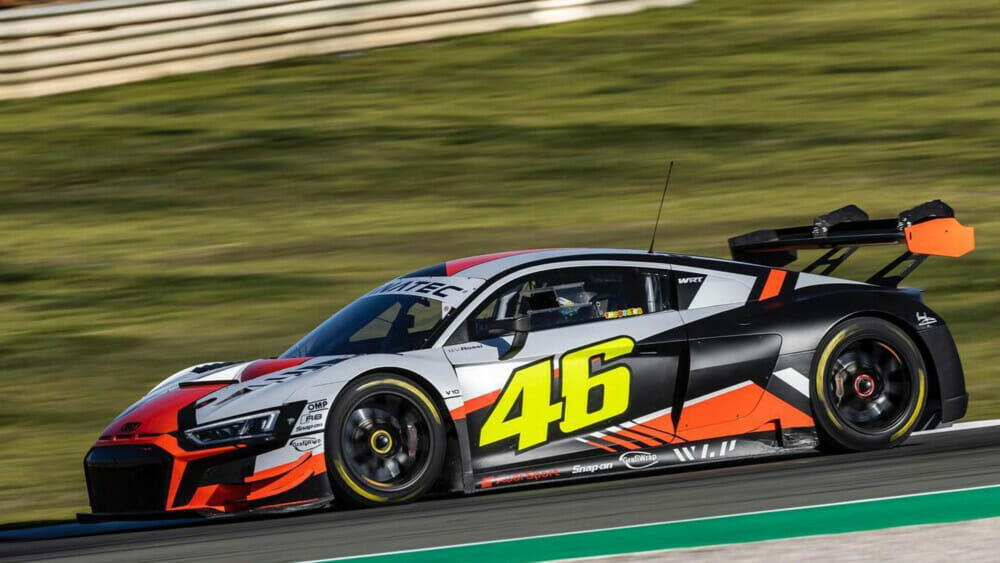Michael Scott | February 2, 2022
Cycle News In The Paddock
COLUMN
Four Wheels Good. Two Wheels Better.
Four into two won’t go. Works okay the other way round, often as not, as at least two of bike racing’s previous GOATS amply demonstrated. Now the most recent Billy the Superkid sets out on a similar journey.
Matter of fact, Valentino Rossi threw away the chance of repeating the Motorbike/Formula 1 glory of his great predecessor John Surtees, despite entreaties from Ferrari after highly promising test outings back in 2006 and again in 2008. The offer was there, but Rossi knew he had more races and titles to win on two wheels, while the risk of failure in deep-end car racing was less attractive.
In any case, he preferred “the taste” of motorcycle racing. A sentiment that echoed long-ago multi champion Geoff Duke. The great innovator and stylist of the 1950s had an outing or two in the factory Aston Martin sports car team but found the toffee-nosed snobbery of the incumbents outweighed any pleasure he felt in being able to translate his racing gifts and intelligence to four wheels.
Rossi’s previous car outings have been mainly on the dark and dirty side: a couple of long-ago top-15s in World Championship rallies in Wales and New Zealand, plus serial success at the year-end “for fun” Rally of Monza series. Which is “for fun” only in name, since top drivers from several World Championship series vie for glory, and big reputations are on the line. Valentino has won it seven times, between 2006 and 2018.
Valentino also ran an impressive single test outing on a NASCAR oval back in 2013, eventually lapping “in the 185-mph region” at Charlotte Motor Speedway in Kyle Busch’s Toyota stock car.
Vale’s other road-racing efforts have been in the Blancpain endurance series, pedaling GT cars, with a couple of 2012 outings in a Ferrari F548, figuring midfield or so in the Pro-Am category, with old mate and right-hand-man Uccio Salucci co-driving.
In January came confirmation that he has signed up for a full 10-race season in the same Blancpain GT World Challenge Europe series, driving a Team WRT Audi R8.
 Valentino Rossi recently tested the Team WRT Audi R8.
Valentino Rossi recently tested the Team WRT Audi R8.
An exciting prospect, but somewhat disappointing for anyone in MotoGP who had been assuming that Vale would remain hands on and ever-present in the bike paddock, overseeing his VR46 teams in all three classes. Almost every one of the 10 car races clashes. For example, when MotoGP is in Argentina, Vale will be racing in Italy, and he’s at Brands Hatch when the bike boys start the European season at Jerez. And so on.
At least for the French GP he will be in the same country, albeit wearing his fire-proof overalls at Magny-Cours while the bikes gallop round Le Mans.
From his point of view, however, it will doubtless be more comfortable than attending bike races without actually riding.
How well will he do?
No reason not to expect excellence, although he’ll be a ripe 43 years old for the first race. Age definitely robbed his last bike-racing years of results, though he was reluctant at first to acknowledge it. But maybe it’s not such a drawback when you’re sitting comfortably in a reclining seat, all strapped in and safe.
After all, car-racing super-legend Juan Manuel Fangio was 40 when he won the first of five championships in 1951, and a ripe 46 for his fifth.
Surtees is the benchmark for bike racers taking to four wheels, the only person to take the World Championship in both categories—seven on two wheels between 1956 and 1960 (three 350cc, four 500cc), and one F1 title for Ferrari in 1964. But there were other notables.
All the way back to before World War Two, Tazio Nuvolari was a giant on four wheels, but had cut his teeth on two, winning the 1925 European Championship (then the summit of the sport) on a 350 Bianchi.
Nine-times champion Mike Hailwood was arguably the man Rossi deposed as GOAT, and while his F1 career was truncated by injury and he never did win a race, he made the podium a couple of times, and was a serious contender.
Less well known: the exploits of Bill Ivy, tiddler champion of the late 1960s and reckoned to be a major talent. He had minimal car outings in a Formula Two Brabham but made a huge impression, not least by setting pole at his first race, where the opposition included such luminaries as F1 Champions Jackie Stewart, Jochen Rindt and Graham Hill. But he needed money to support his proposed new career and went back to bike racing to earn it, only to die when his 350 Jawa seized in practice for the German GP at the Sachsenring.
Not the most cheerful example when thinking of Valentino’s switch to cars, but perhaps a warning that he would do well to stay there. CN
Click here for all the latest MotoGP news.